MIST
Magnetosphere, Ionosphere and Solar-Terrestrial
Nuggets of MIST science, summarising recent papers from the UK MIST community in a bitesize format.
If you would like to submit a nugget, please fill in the following form: https://forms.gle/Pn3mL73kHLn4VEZ66 and we will arrange a slot for you in the schedule. Nuggets should be 100–300 words long and include a figure/animation. Please get in touch!
If you have any issues with the form, please contact This email address is being protected from spambots. You need JavaScript enabled to view it..
The Impact of Radiation Belt Enhancements on Electric Orbit Raising
By Alexander Lozinski (British Antarctic Survey)
Electric orbit raising is a method of getting satellites into geostationary orbit (GEO) using low-thrust electric propulsion. A satellite intended for GEO is first placed into elliptical geostationary transfer orbit after separating from the launch vehicle. Following this, maneuvers are performed to raise the satellite to GEO. In conventional launches, chemical propulsion is used and this process requires a few days. With electrical thrusters, orbit raising can be performed more efficiently but requires a longer period (around 200 days) due to the lower thrust.
This method of raising satellites was introduced commercially in 2014 with the launch of the first all-electric satellites. Although the lower wet mass due to lack of chemical propellant reduces launch costs, the longer time required for the satellite to reach GEO leaves it exposed to irradiation from trapped protons of the Van Allen belts. This can cause degradation to solar cells via non-ionising displacement collisions.
Sustained enhancements in trapped proton flux can occur via trapping of solar energetic particles following a large geomagnetic disturbance. In this work, the solar cell degradation through time for a variety of real electric orbit raising scenarios was calculated in both a quiet and active environment, based on measurements taken by CRRES before/after the March 1991 storm. The trajectories of two previously launched satellites (EOR-1 and EOR-2) that underwent electric orbit raising is shown in the figure. The figure also shows the calculated remaining output power of the solar cell, P/P0, through time for both trajectories in an active environment. Reductions in P/P0 represent degradation to the solar cells.
A key finding is a large (up to 5%) increase in P/P0 degradation that occurs when electric orbit raising is performed in an enhanced radiation belt environment. However, the figure also demonstrates that some orbits are more at risk than others. Orbits with a higher initial apogee (e.g. EOR-2, red line) spend less time in regions of high proton flux, and experience less degradation. The work highlights the significant impacts of an enhanced environment on solar cell degradation, and identifies how this degradation can in part be mitigated with an appropriate choice of orbit and shielding.
For more information, please see the paper:
Lozinski, A. R., Horne, R. B., Glauert, S. A., Del Zanna, G., Heynderickx, D., & Evans, H. D. R. ( 2019). Solar cell degradation due to proton belt enhancements during electric orbit raising to GEO. Space Weather, 17. https://doi.org/10.1029/2019SW002213
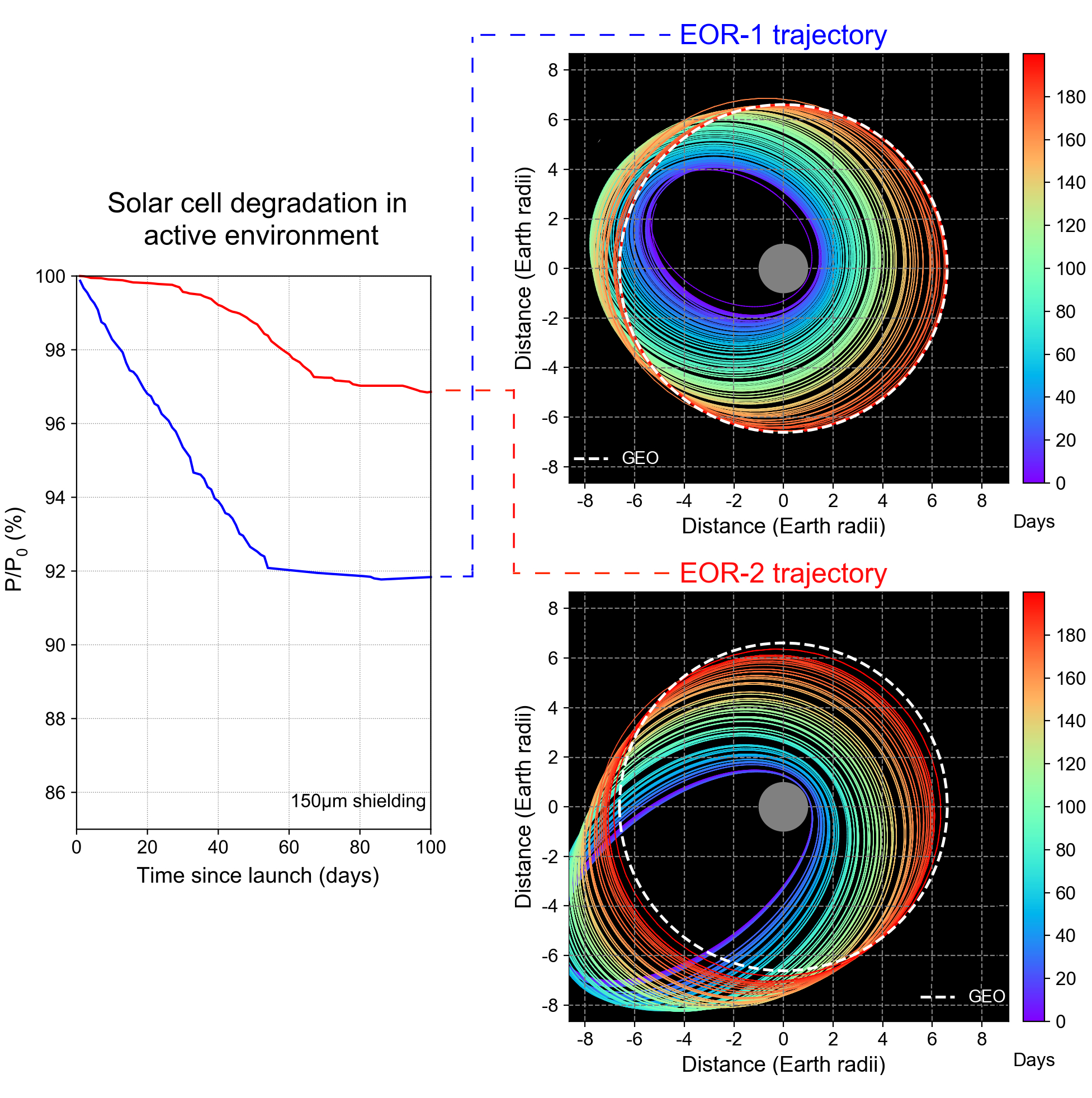
Figure caption: The left panel shows the remaining power, P/P0, as a function of time for two satellites. The right panels show trajectories of the two satellites over the first 200 mission days.
SuperDARN Observations During Geomagnetic Storms, Geomagnetically Active Times, and Enhanced Solar Wind Driving
by Maria-Theresia Walach (Lancaster University)
At Earth, solar wind coupling drives large scale convection of field lines: antisunward flow of open field lines at high latitudes and the return flow of closed field lines at lower latitudes. This convection can be observed through measurements of the ionosphere, for example using measurements from SuperDARN, an international network of ground based radars, purposely built to study ionospheric convection. We use 7 years of Super Dual Auroral Radar (SuperDARN) data to study ionospheric convection during geomagnetic storms, geomagnetically active times and solar wind driven times. Using the most recent years of SuperDARN data allows us to study ionospheric convection at the mid-latitudes with a field-of-view spanning from the pole to 40 degrees of magnetic latitude.
In this study, we address a number of questions; for example, do we make similar SuperDARN observations during similar solar wind driving during nonstorm time as during storm time? Do SuperDARN observations change throughout the different phases of a storm? Where do we see the fastest flows with SuperDARN, and is it linked to the extent of latitudinal coverage from the radars? Does the latitudinal range of the convection, given, for example, by the return flow region, stay constant throughout a storm? We find that initial and recovery phases of geomagnetic storms show similar convection as enhanced solar wind driving when no geomagnetic storm occurs.
One of the key findings showing the change of regime between the initial, main, and recovery phase of the storm is shown in the figure: it shows the varying relationship between the flow reversal boundary (here FRB but otherwise known as the open-closed field line boundary or polar cap boundary) and the Heppner-Maynard boundary (here HMB, which corresponds to the lower latitude boundary where the ionospheric convection electric field approaches 0 kV). The blue line shows the line of best fit and the data distribution along it, indicates that the boundaries must expand and contract together, however, this happens at different rates during the different storm phases, producing an inflated return flow region during the main phase of the storm.
For more information, please see the paper below:
, & ( 2019). SuperDARN observations during geomagnetic storms, geomagnetically active times, and enhanced solar wind driving. Journal of Geophysical Research: Space Physics, 124. https://doi.org/10.1029/2019JA026816
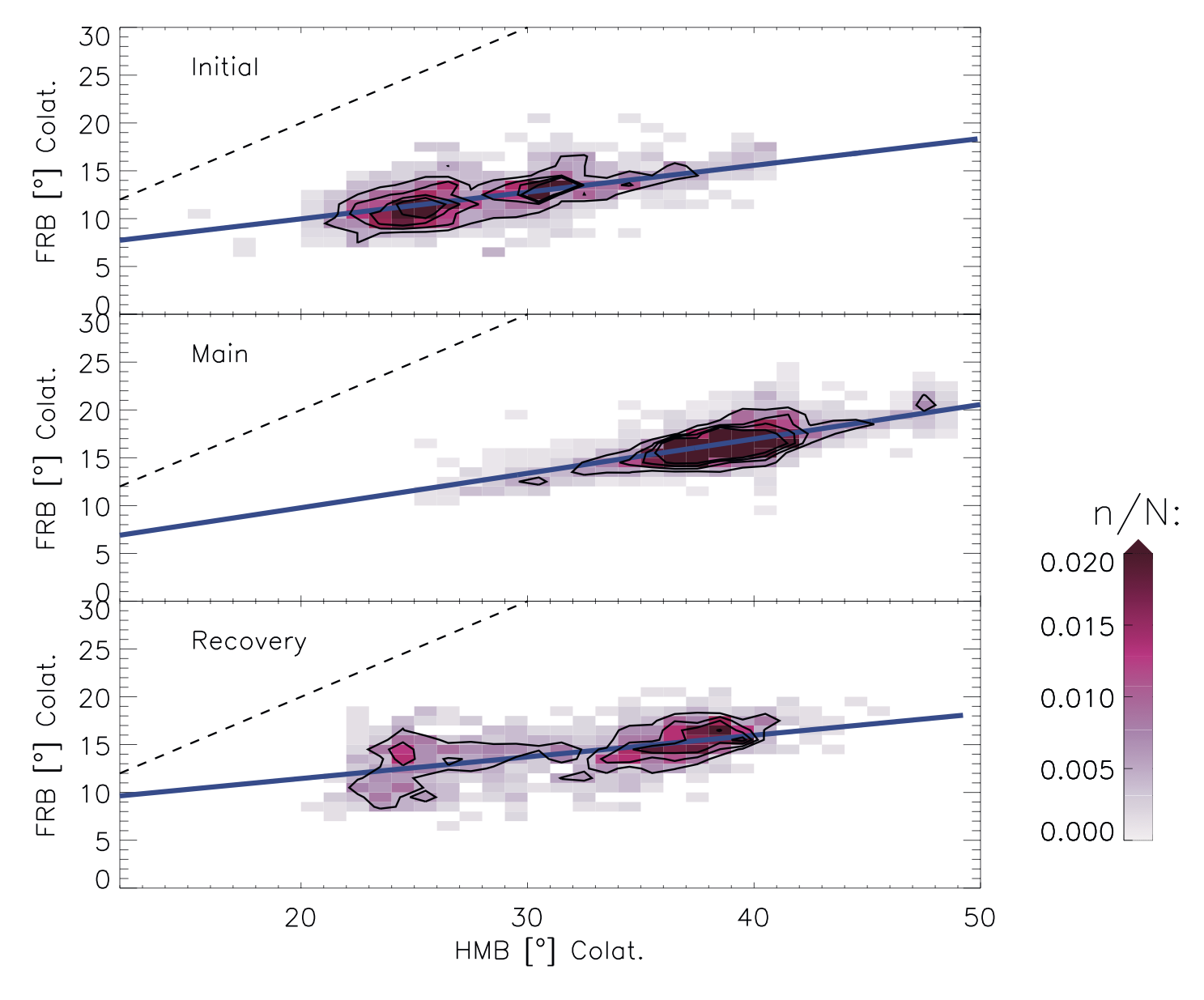
Figure: Colatitude location of the flow reversal boundary (FRB) against the Heppner‐Maynard boundary (HMB) during the three phases of geomagnetic storms (only using maps where n ≥ 200). The dashed black lines show the line of unity and the black contours correspond to where the normalized data point density corresponds to 0.005, 0.01, 0.015, and 0.02.
Exploring Key Characteristics in Saturn’s Infrared Auroral Emissions Using VLT-CRIRES: H3+ Intensities, Ion Line-of-Sight Velocities, and Rotational Temperatures
by Nahid Chowdhury (University of Leicester)
Saturn’s aurorae are generated by interactions between high-energy charged particles and neutral atoms in the upper atmosphere. Infrared observations of auroral emissions make use of H3+ – a dominant hydrogen ion in Saturn’s ionosphere – that acts as a tracer of energy injected into the ionosphere.
We analysed observations taken in May 2013 of Saturn’s northern infrared auroral emissions with the Very Large Telescope in Chile using the CRIRES instrument. The use of adaptive optics, combined with the high spectral resolution of VLT-CRIRES (100,000), meant that this dataset offered an unprecedented spatially and spectrally resolved ground-based view of Saturn's infrared aurora. Using discrete H3+ emission lines, we derived dawn-to-dusk auroral emission intensity, ion line-of-sight velocity, and thermospheric temperature profiles, allowing us to probe the physical properties of Saturn’s polar atmosphere.
Our analysis showed an enhancement in the dawn-side auroral emission intensity, a common feature that is known to be linked with solar-wind compressions in the kronian magnetosphere, and the presence of a localised dark region in the aurora very close to the pole. The ion line-of-sight velocity profile revealed previously unknown smaller-scale structures in the ion flows. In particular, the ion flows near the centre of the pole (at position B in Figure 1) could be consistent with the behaviour of a relatively small ionospheric polar vortex whereby the ions are interrupting the general dawn-to-dusk trend in movement to instead adopt a very sharp shearing motion of ions first toward midnight and then almost immediately back toward noon. Our thermospheric temperature derivations also reveal a very subtle temperature gradient that increases from 350 K on the dawn-side of the pole to 389 K on the dusk-side.
This work has bought to light complex features in the behaviour of H3+ ions in Saturn’s upper atmosphere for the first time and highlights the need for additional analyses of two-dimensional scanned maps of Saturn’s auroral regions with a view to addressing some of the major outstanding questions surrounding Saturn’s thermosphere-ionosphere-magnetosphere interaction.
For more information, please see the paper below:
, , , & ( 2019). Exploring key characteristics in Saturn's infrared auroral emissions using VLT‐CRIRES: H3+intensities, ion line‐of‐sight velocities, and rotational temperatures. Geophysical Research Letters, 46. https://doi.org/10.1029/2019GL083250.
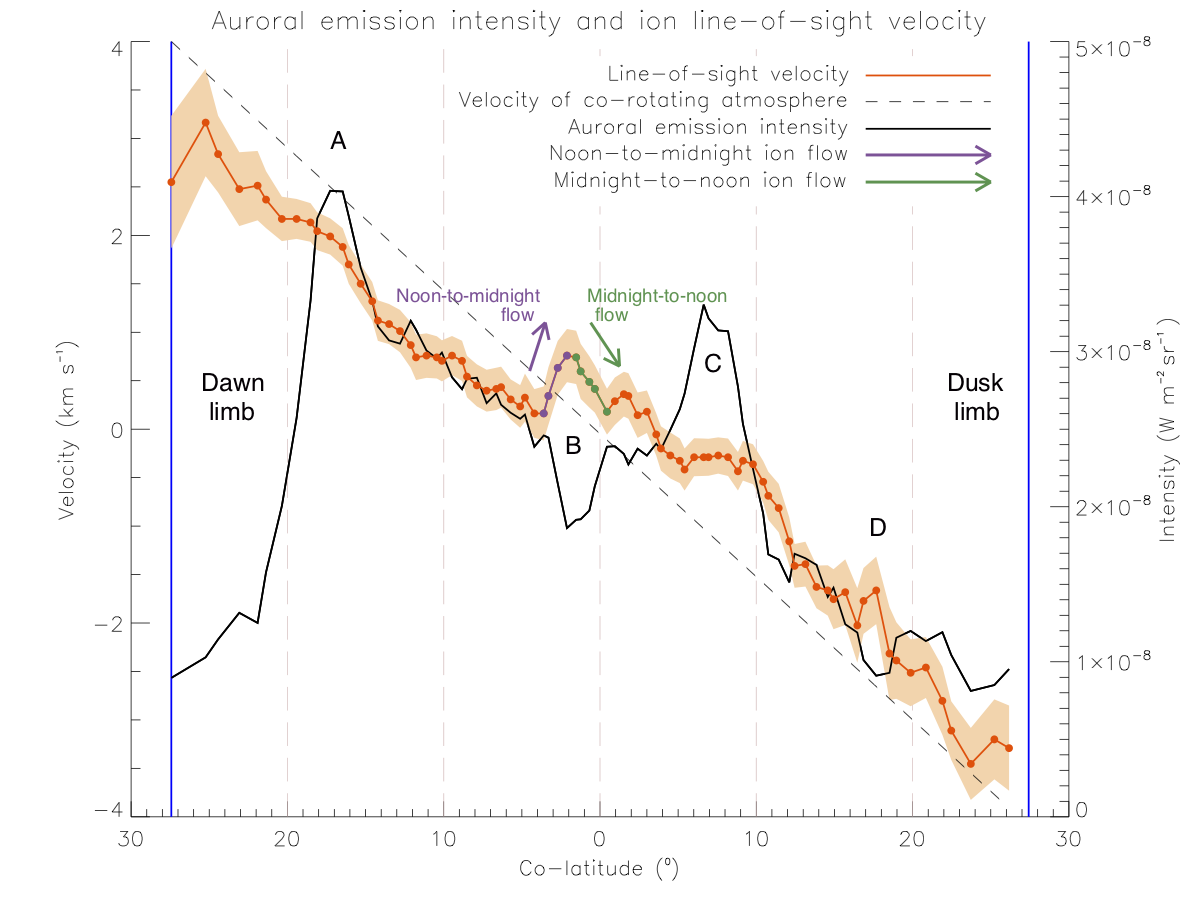
Figure 1: The ion line-of-sight velocity and auroral emission intensity profiles are plotted as a function of co-latitude on the planet. Evidence for ion flows possibly consistent with the behaviour of an intriguing ionospheric polar vortex is adjacent to the area marked by the letter B, between approximately 0⁰ and 5⁰ co-latitude on the dawn-side of Saturn’s northern pole.
Directed network of substorms using SuperMAG ground-based magnetometer data
by Lauren Orr (University of Warwick)
Space weather can cause large-scale currents in the ionosphere which generate disturbances of magnetic fields on the ground. These are observed by >100 magnetometer stations on the ground. Network analysis can extract the important information from these many observations and present it as a few key parameters that indicate how severe the ground impact will be. We quantify the spatio-temporal evolution of the substorm ionospheric current system utilizing the SuperMAG 100+ magnetometers, constructing dynamical directed networks from this data for the first time.
Networks are a common analysis tool in societal data, where people are linked based on various social relationships. Other examples of networks include the world wide web, where websites are connected via hyperlinks, or maps where places are linked via roads. We have constructed networks from the magnetometer observations of substorms, where magnetometers are linked if there is significant correlation between the observations. If the canonical cross-correlation (CCC) between vector magnetic field perturbations observed at two magnetometer stations exceeds a threshold, they form a network connection. The time lag at which CCC is maximal, |τC|, determines the direction of propagation or expansion of the structure captured by the network connection. If spatial correlation reflects ionospheric current patterns, network properties can test different models for the evolving substorm current system.
In this study, we select 86 isolated substorms based on nightside ground station coverage. The results are shown for both a single event and for all substorms in the figure. We find, and obtain the timings for, a consistent picture in which the classic substorm current wedge (SCW) forms, quantifying both formation and expansion. A current system is seen pre-midnight following the SCW westward expansion. Later, there is a weaker signal of eastward expansion. Finally, there is evidence of substorm-enhanced magnetospheric convection. These results demonstrate the capabilities of network analysis to understand magnetospheric dynamics and provide new insight into how the SCW develops and evolves during substorms.
For more information please see the paper below:
Orr, L., Chapman, S. C., and Gjerloev, J. W.. ( 2019), Directed network of substorms using SuperMAG ground‐based magnetometer data. Geophys. Res. Lett., 46. https://doi.org/10.1029/2019GL082824
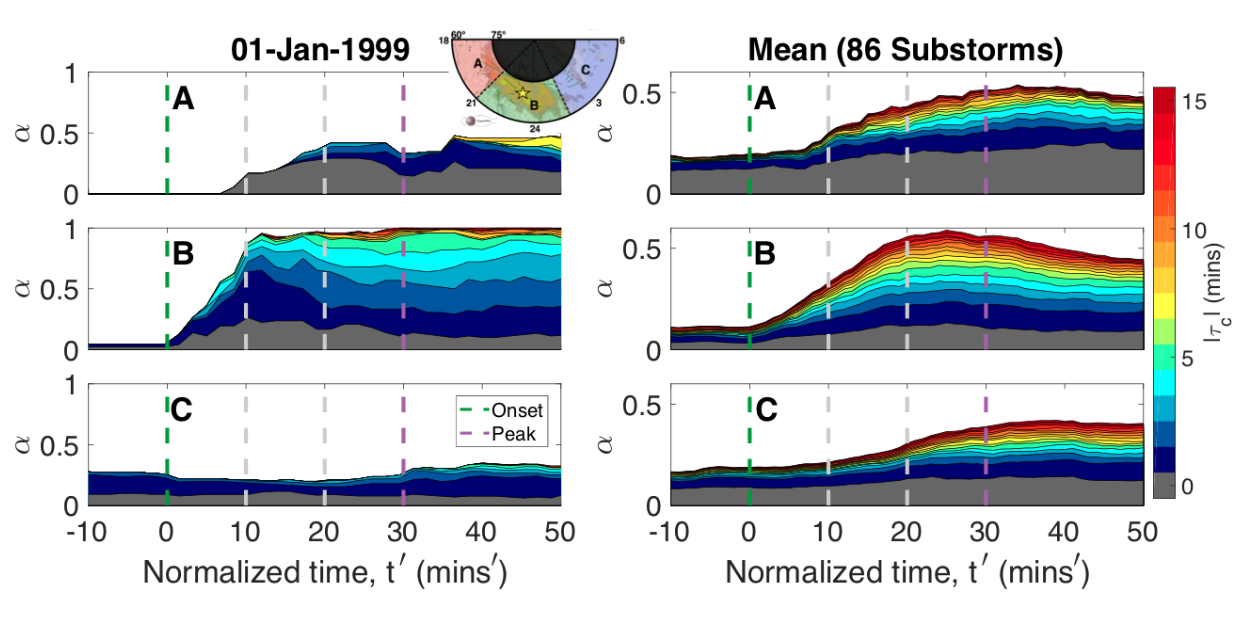
Figure: The normalized number of connections, α(t',τC), is binned by the lag of maximal canonical cross-correlation, |τC|. Each panel stacks, one above the other, α(t',τC) versus normalized time, t’, for |τC|≤15. The regions are indicated on the polar plot and the regions were determined using Polar VIS images of the auroral bulge at the time of maximum expansion. Region B (around onset) exhibits a rapid increase in correlation following substorm onset.
Long-term variations in solar wind parameters, magnetopause location, and geomagnetic activity over the last five solar cycles
by Andrey Samsonov (Mullard Space Science Laboratory, UCL)
The magnetopause is a natural boundary between the solar wind and magnetospheric plasmas. Geosynchronous orbit, where numerous communications, meteorological and GPS satellites operate, is usually located in the magnetosphere but occasionally due to variable solar wind conditions the magnetosphere may significantly compress and those satellites will cross the magnetopause and get in direct contact with the solar wind plasma. Fast streams of dense solar wind plasma as well as solar energetic particles might damage the satellites. Therefore the study of variations of the magnetopause standoff distance is an important problem of space physics. The magnetopause location can be described by empirical models (e.g. Shue et al., 1998; Lin et al., 2010).
In our recent work, we studied long term changes in the magnetopause position. We use both OMNI solar wind observations and empirical magnetopause models to reconstruct time series of the magnetopause standoff distance for nearly five solar cycles (from 1966 to 2018). The magnetopause standoff distance on this time scale depends mostly on the solar wind dynamic pressure (Pdyn). The 11-year solar cycles in the Pdyn variations are superimposed by an increasing trend before 1991 and a decreasing trend between 1991 and 2009. Correspondingly, we find that the standoff distance predicted by magnetopause models increases by nearly 2 RE from 1991 to 2009. The annual sunspot number (SSN), IMF magnitude and magnetospheric geomagnetic activity indices display the same trends as the dynamic pressure. We calculate extreme solar wind parameters and magnetopause standoff distance in each year using daily values and find that both extremely small and large standoff distances during a solar cycle preferably occur at solar maximum rather than at solar minimum (see figure below).
Furthermore, we calculated correlations between annual average solar wind and magnetospheric parameters, and the SSN. The annual IMF magnitude well correlates with SSN with a zero time lag, while the annual Pdyn correlates reasonably well with the SSN but with 3-years time lag. Both the annual solar wind density and velocity well correlate with the dynamic pressure, but the correlation coefficient is higher for density than for velocity. The annual Kp index better correlates with Pdyn, while Dst index better correlates with Bs (negative IMF Bz). This correlation analysis helps to better understand relations between solar, solar wind and magnetospheric parameters on the long time scale.
The knowledge of predicted magnetopause position for the next solar cycle is important for future space missions, especially for those which are intended to observe the dayside magnetopause whether in situ or remotely. One of the forthcoming missions which will study variations of the dayside magnetopause is the Solar Wind Magnetosphere Ionosphere Link Explorer (SMILE).
For more information, please see the paper below:
Samsonov, A. A., Bogdanova, Y. V., Branduardi‐Raymont, G., Safrankova, J., Nemecek, Z., & Park, J.‐S. ( 2019). Long‐term variations in solar wind parameters, magnetopause location, and geomagnetic activity over the last five solar cycles. Journal of Geophysical Research: Space Physics, 124. https://doi.org/10.1029/2018JA026355
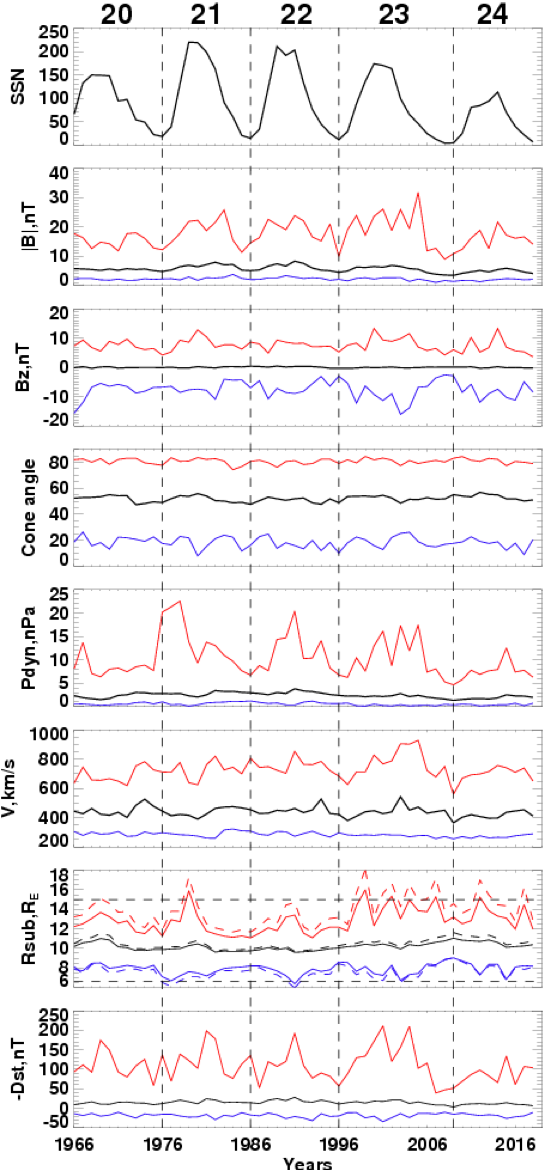
Figure: The sunspot numbers, average and extreme IMF magnitude and Bz, IMF cone angle (the angle between IMF vector and xaxis), solar wind dynamic pressure and velocity, magnetopause standoff distance (solid lines for Shue et al.'s model and dashed lines for Lin et al.'s model), and geomagnetic Dst index. Annual average values shown by black, daily maximal and minimal values for each year shown by red and blue. Vertical lines separate solar cycles as indicated by numbers at the top.